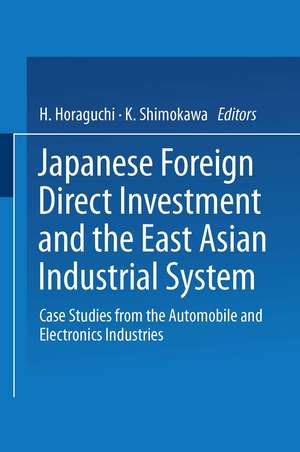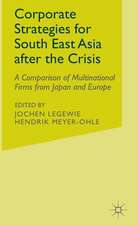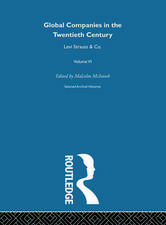Japanese Foreign Direct Investment and the East Asian Industrial System: Case Studies from the Automobile and Electronics Industries
Editat de H. Horaguchi, K. Shimokawaen Limba Engleză Paperback – 19 apr 2014
Preț: 392.60 lei
Nou
Puncte Express: 589
Preț estimativ în valută:
75.13€ • 80.33$ • 62.64£
75.13€ • 80.33$ • 62.64£
Carte tipărită la comandă
Livrare economică 17 aprilie-01 mai
Preluare comenzi: 021 569.72.76
Specificații
ISBN-13: 9784431669920
ISBN-10: 4431669922
Pagini: 372
Ilustrații: VIII, 363 p. 8 illus.
Dimensiuni: 155 x 235 x 20 mm
Greutate: 0.52 kg
Ediția:2002
Editura: Springer
Colecția Springer
Locul publicării:Tokyo, Japan
ISBN-10: 4431669922
Pagini: 372
Ilustrații: VIII, 363 p. 8 illus.
Dimensiuni: 155 x 235 x 20 mm
Greutate: 0.52 kg
Ediția:2002
Editura: Springer
Colecția Springer
Locul publicării:Tokyo, Japan
Public țintă
ResearchDescriere
Japanese foreign direct investment has played a leading role in Asian economies for more than two decades. This book, describing the changing industrial dynamics after the Asian currency crisis in 1997, focuses on corporate strategies of Japanese automobile and electronics companies in Asian nations, with detailed analysis of management issues and strategies from the viewpoint of both the home economy and the recipient host economies. Among the cases presented are the global restructuring of the Korean automobile industry and the transfer of automotive technology to China via Taiwan. Other studies, from the electronics industry, look at production sites in Malaysia, backward integration in Singapore, and forward integration in Hong Kong. The contributions of specialists from Asia, Europe, and the United States collected here envision an ongoing process of globalization and provide valuable perspective and background for business management and East Asian studies.
Cuprins
1 Post-Crisis Asian Economies: Some New Industrial Prospects.- 2 Trends in Multinational Strategies and Organizations in the Asia-Pacific.- 3 Japanese Multinational Enterprises and AFTA: Restructuring and Market Segmentation.- 4 AFTA in the Globalization Process: Perspectives from Industries in Malaysia.- 5 Globalization of Electronics Production Networks and the Emerging Roles and Strategies of Singapore Contract Manufacturers.- 6 Expansion Options among Hong Kong Electronics Firms: A Study of Effective Marketing Channel Strategies.- 7 Issues on the Restructuring of the Korean Automobile Industry.- 8 Leveraging Capabilities: Models of Foreign Production in the Taiwanese Automotive Industry.- 9 The Changes in the Automobile Industry in Thailand.- 10 Reevaluation of the International Division of Labor in Japan’s Automobile Industry in Asia.- 11 The Tire Industry: A Comparative Study About the Strategy of Internationalization of French and Japanese Multinationals.- 12 Evolution of Global Product Development Strategy: A Case of “Asia Car”.- 13 Taiwanese Technology Transfer to China: The Automobile Industry as a Case Study.- 14 Technology Transfer of the Toyota Production System in China.- 15 Hybrid Factory in Asia: A Case of Mitsubishi Motors Corporation.- Author and Company Index.
Caracteristici
This book describes changing industrial dynamics of automobile and electronics industry after the Asian currency crisis in 1997. This contributes to the policy guidelines as well as corporate strategy for internationalization. International collaboration is organized among scholars from Korea, Taiwan, Hong Kong, Singapore, Japan, China, Thailand, Malaysia, France and the United States. Field surveys on the two industries provide rich information and basic understandings on the issues. Japanese Foreign Direct Investment (FDI) has been playing a leading role in the Asian economies for more than two decades. Even though the myth of the "East Asian Miracle" was severely hit by the 1997 Asian Economic Crisis, Japanese Multinational Corporations (MNCs) have achieved organizational evolutions in their market places
While Korean automobile manufacturers have experienced global restructuring, Chinese automobile industry have successfully transferred its production technology from Japan via Taiwan. Electronics production has its production site in Malaysia and its backward integration is observed in Singapore whilst its forward integration is done in Hong Kong. Globalization in the early twenty first century is envisaged in this book through international collaboration in East Asian and the Western countries
While Korean automobile manufacturers have experienced global restructuring, Chinese automobile industry have successfully transferred its production technology from Japan via Taiwan. Electronics production has its production site in Malaysia and its backward integration is observed in Singapore whilst its forward integration is done in Hong Kong. Globalization in the early twenty first century is envisaged in this book through international collaboration in East Asian and the Western countries

















